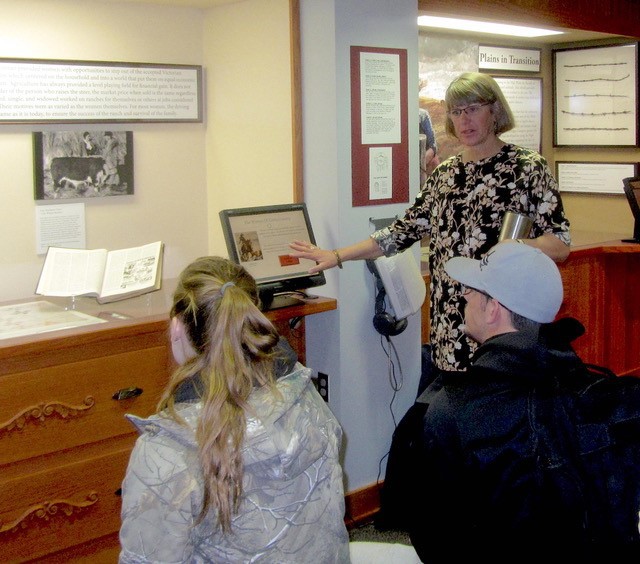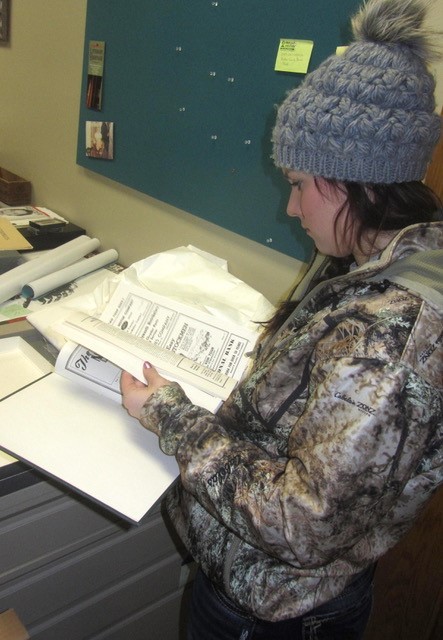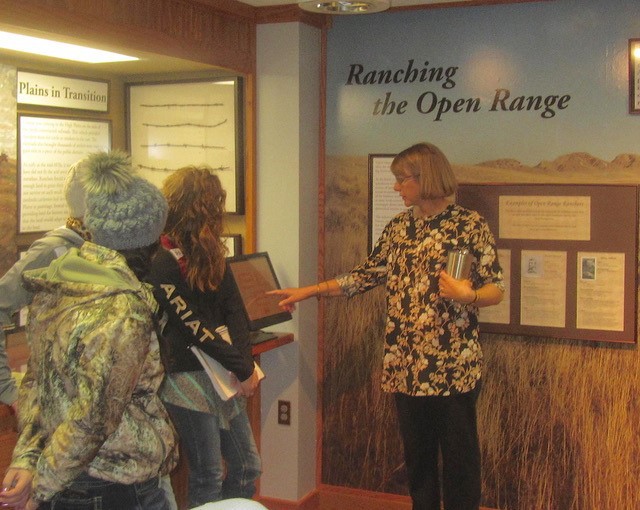CSC ag students introduced to area's ranching history

CHADRON – Although many students in the agriculture and range management department at Chadron State College hail from the High Plains region and are familiar with farms and ranches, they often have only scant knowledge of the colorful, 200-year history of cattle raising on the American prairie.
That’s why Applied Sciences Associate Professor Dr. Ron Bolze brought his introductory classes on beef production and range management to the Mari Sandoz High Plains Heritage Center in late January for an introduction to the resources at the C.F. Coffee Gallery by historian and rancher Tammi Littrel, who helped research and create many of the gallery exhibits.
“I wanted the students to know about the history of the cattle industry in the western High Plains,” said Bolze. “Tammi is an expert on the history of beef production on the High Plains.”
Located in the lower level of the Sandoz Center, the Coffee Gallery tells the story of cattle ranching on the North American plains, beginning with the earliest cattle drives that brought longhorns north from Texas.
The longhorns, descendants of Spanish cattle that Christopher Columbus brought to a Caribbean island in 1493, were moved onto the northern plains in the mid-1800s to fill the void left by the near extinction of the buffalo and the forced relocation of native Indians to reservations, Littrel told the students.
“You have this vast area of land, in public domain, and all this grass. People wanted to use it for another ungulate, cattle,” she said.
There were many missteps and failures in the process that led to the modern cattle business, Littrel’s talk made clear. The Texas system of ranching – letting the half-wild longhorns fend for themselves most of the year – failed due to harsh winter storms, she said. And, despite warnings the region was too arid for farming, Congress encouraged homesteaders to raise crops on small parcels of prairie land.
“They tried to match (type of agriculture) to the geography east of the Mississippi (River),” Littrel said. “It wouldn’t work. People planted corn and they starved out.”
The Midwestern system of ranching, with its focus on animal husbandry and selective breeding, eventually came to dominate the northern range lands, Littrel said.
“What happened was, those who were successful adapted. They just learned how to do things,” she said.
The gallery’s exhibit on open range ranchers, who grazed their cattle on unfenced public lands, focuses on three men who played a large role in the history of the region around Chadron: Bartlett Richards, C.F. Coffee and Harry Oelrichs. An interactive display explains their backgrounds and the adaptations they made as homesteaders settled on the prairie.
A newly opened exhibit shows how early cattlemen did business in the absence of a formal banking system and gradually moved into finance themselves. Without a way to transfer money, cowboys would sometimes secretively carry huge amounts of cash on long journeys across the prairies, Littrel said.
“Trail bosses had the forerunner of the fanny pack,” she said, pointing out a weathered money belt in the display.
Owners of big herds had to make complex, handshake deals for large sums.
“There was nothing written. You had to be trusted,” she said.
Littrel, a former history instructor at CSC, also showed students the exhibit on “Women of Cattle Country,” which includes a section on renowned quilter Grace McCance Snyder. Snyder, author of a book on her pioneer life in Nebraska, is featured in a traveling exhibit called “Of Cows and Quilts” on loan to the Cozad Public Library. In another outreach effort for the Coffee Gallery, Littrel, who is a distant relative of McCance, gave a talk about the exhibit on Jan. 30 in Cozad.
The classes also toured the Sandoz Center with director Sarah Polak, who talked about the life and career of author Mari Sandoz.
Polak noted that every semester classes from a variety of fields, including agriculture, history, art and social work, visit the displays and use materials at the Sandoz Center and Coffee Gallery.
The Sandoz Center and Coffee Gallery are located in the former CSC library building. Admission is free. Hours are Monday-Friday 8 a.m. to noon and 1 p.m. to 4 p.m. and Saturday 9 a.m.-noon and 1 p.m.to 4 p.m. For more information, visit www.sandozcenter.com.
Related story: Sandoz Center acquires 'True West' archives
Category: Campus News, Range Management, Sandoz Society


